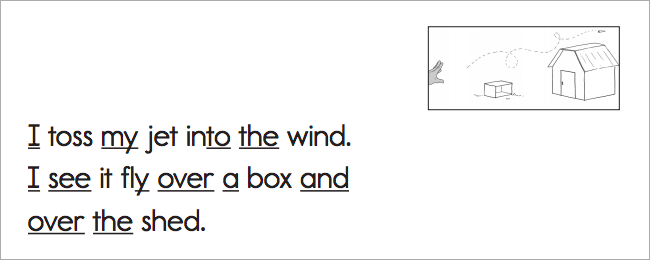I was determined to undo the bad reading habits my students had developed during guided reading. I exchanged a leveled reading program for one with decodables and used a diagnostic phonics assessment to regroup my students.
For some students, cracking the code was easy
Students with strong phonemic awareness linked the sounds they heard in spoken words to the letter patterns I taught. When they came to an unfamiliar word in a text, they sounded it out.
Most of the time, simply pronouncing the word was enough to trigger the meaning.
Blue group reading: “Sam has a little p.l.ă.s.t.i.c … PLASTIC! ship.
But sometimes they sounded out a word and didn’t immediately know what it meant.

Me: Do you know what a shed is?
Angel: [pause] I think it’s a house where you could put tools and boxes.
Alexa: It’s this! [pointing to the picture]
My students used context and visuals to figure out the meaning of a word after decoding it; the inverse of guided reading, in which they had attempted to use meaning and context to identify words.
Linking the spelling, pronunciation, and meaning of each newly encountered word (a process called orthographic mapping) made every successive encounter with that word easier.
Some of my students quickly became fluent readers. They grew out of decodable texts and began ravenously reading books from the library.
But it wasn’t easy for all students
I had taught phonics in guided reading, but leveled books had allowed students to use pictures, initial sounds, and context to guess rather than sound out words. Decodable books foiled these guessing strategies by including visually similar words (man/mat, run/ran) and unpredictable sentence structures that required students to look at all the letters in words and all the words in sentences. To read decodables, we had to actively fight the reading behaviors I had once promoted in guided reading. Progress was labor-intensive and painfully slow for some of my students.
Was this really reading?
Sounding out each word took so long that by the time they got to the end of a sentence, students didn’t know what they had read. I worried that I was creating “word callers” (and they weren’t even “calling” the words very well!)
I looked for answers
Dr. John Shefelbine empathized when I told him about the misery of my lowest reading group. He explained:
“The kindest thing you can do for beginning and struggling readers is to give them the time and encouragement they need to grunt and groan their way through sounding out words. You’re rewiring their brains and it’s hard work.”
I was astounded to learn that scientists had been studying how our brains learn to read for decades and yet none of that research had influenced my teacher preparation or professional development. I watched videos like Reading and the Brain , read articles like What the Brain Does When It Reads , and lost myself in books like Reading In the Brain and Proust and the Squid. I wanted to learn everything I could about my students’ development so that I could make every child a reader.
New learning prompted me to redefine skilled teaching
I had previously thought of teaching as an improvisational art, but as a first-grade reading teacher, I was a neurosurgeon painstakingly practicing a new procedure. I memorized instructional routines, taught each lesson as it was designed, observed my readers’ symptoms, and I collected objective data.
I had been taught that every child learns to read differently and that “no one thing will work for all readers.” But this year, I saw each of my students progress through the same stages of reading development, albeit at different rates.
We TEACH reading in different ways; they LEARN to read proficiently in only one way. Teaching is what we do- learning is what their brains do.
— Dr. David Kilpatrick
The same series of lessons, with varying amounts of practice, resulted in every one of my students learning to crack the code of written English.
The fastest way to authentic texts
Students need varying amounts of explicit instruction and practice to become skilled at decoding. Guided reading and predictable texts don’t offer many opportunities to blend words, so students who need lots of practice fall farther and farther behind.
“Leveled texts lead to leveled lives.”
— Dr. Alfred Tatum
Differentiated instruction with decodable texts in the primary grades closes an achievement gap that might otherwise become insurmountable. The sooner children learn how to lift the words off the page, the sooner they can access great literature.
Receiving the instruction and practice their brains needed to become skilled at decoding changed the trajectory of my students’ lives.
Finding decodable texts
Free decodable texts aligned with phonics skills
Use this scope and sequence to match a decodable text with the spelling pattern you’re teaching: Free Decodable Texts for Each Phonics Skill . This resource is from our sister project, Reading Universe .
Decodables from publishers
This list of links, compiled by The Reading League, includes decodable text sources for students in grades K-2, 3-8, teens, and all ages. Decodable Text Sources ›

